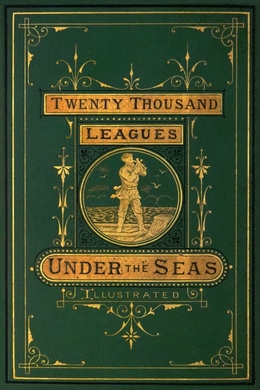
20,000 Leagues Under the Sea
A Tour of the Underwater World
by Jules Verne
subjects: Classic Science Fiction
series: Extraordinary Voyages (#6)
-
EPUB 356 KB
-
Kindle 444 KB
-
Support epubBooks by making a small $2.99 PayPal donation purchase.
Description
A mission to rid the seas of a monstrous creature becomes a terrifying nightmare when Professor Arronax, Conseil and Ned Land are thrown overboard. The huge marine animal which has haunted the water is no living beast, but a spectacular man-made vessel, and the three men find themselves the helpless prisoners of Captain Nemo. Resigned to their fate, they begin a miraculous journey on the submarine ship which can travel through waters never before explored. For the Professor, at least, this voyage is one he would not have missed for the world.
411 pages with a reading time of ~6.25 hours (102935 words), and first published in 1870. This DRM-Free edition published by epubBooks, 2009.
Community Reviews
-
A Great Novel, an ultimate fiction story that will never fade in time.
May 21
Excerpt
The year 1866 was signalised by a remarkable incident, a mysterious and puzzling phenomenon, which doubtless no one has yet forgotten. Not to mention rumours which agitated the maritime population and excited the public mind, even in the interior of continents, seafaring men were particularly excited. Merchants, common sailors, captains of vessels, skippers, both of Europe and America, naval officers of all countries, and the Governments of several States on the two continents, were deeply interested in the matter. For some time past vessels had been met by “an enormous thing,” a long object, spindle-shaped, occasionally phosphorescent, and infinitely larger and more rapid in its movements than a whale. The facts relating to this apparition (entered in various log-books) agreed in most respects as to the shape of the object or creature in question, the untiring rapidity of its movements, its surprising power of locomotion, and the peculiar life with which it seemed endowed. If it was a whale, it surpassed in size all those hitherto classified in science. Taking into consideration the mean of observations made at divers times–rejecting the timid estimate of those who assigned to this object a length of two hundred feet, equally with the exaggerated opinions which set it down as a mile in width and three in length–we might fairly conclude that this mysterious being surpassed greatly all dimensions admitted by the learned ones of the day, if it existed at all. And that it DID exist was an undeniable fact; and, with that tendency which disposes the human mind in favour of the marvellous, we can understand the excitement produced in the entire world by this supernatural apparition. As to classing it in the list of fables, the idea was out of the question. On the 20th of July, 1866, the steamer Governor Higginson, of the Calcutta and Burnach Steam Navigation Company, had met this moving mass five miles off the east coast of Australia. Captain Baker thought at first that he was in the presence of an unknown sandbank; he even prepared to determine its exact position when two columns of water, projected by the mysterious object, shot with a hissing noise a hundred and fifty feet up into the air. Now, unless the sandbank had been submitted to the intermittent eruption of a geyser, the Governor Higginson had to do neither more nor less than with an aquatic mammal, unknown till then, which threw up from its blow-holes columns of water mixed with air and vapour. Similar facts were observed on the 23rd of July in the same year, in the Pacific Ocean, by the Columbus, of the West India and Pacific Steam Navigation Company. But this extraordinary creature could transport itself from one place to another with surprising velocity; as, in an interval of three days, the Governor Higginson and the Columbus had observed it at two different points of the chart, separated by a distance of more than seven hundred nautical leagues. Fifteen days later, two thousand miles farther off, the Helvetia, of the Compagnie-Nationale, and the Shannon, of the Royal Mail Steamship Company, sailing to windward in that portion of the Atlantic lying between the United States and Europe, respectively signalled the monster to each other in 42° 15’ N. lat. and 60° 35’ W. long. In these simultaneous observations they thought themselves justified in estimating the minimum length of the mammal at more than three hundred and fifty feet, as the Shannon and Helvetia were of smaller dimensions than it, though they measured three hundred feet over all. Now the largest whales, those which frequent those parts of the sea round the Aleutian, Kulammak, and Umgullich islands, have never exceeded the length of sixty yards, if they attain that. In every place of great resort the monster was the fashion. They sang of it in the cafes, ridiculed it in the papers, and represented it on the stage. All kinds of stories were circulated regarding it. There appeared in the papers caricatures of every gigantic and imaginary creature, from the white whale, the terrible “Moby Dick” of sub-arctic regions, to the immense kraken, whose tentacles could entangle a ship of five hundred tons and hurry it into the abyss of the ocean. The legends of ancient times were even revived. Then burst forth the unending argument between the believers and the unbelievers in the societies of the wise and the scientific journals. “The question of the monster” inflamed all minds. Editors of scientific journals, quarrelling with believers in the supernatural, spilled seas of ink during this memorable campaign, some even drawing blood; for from the sea-serpent they came to direct personalities.
